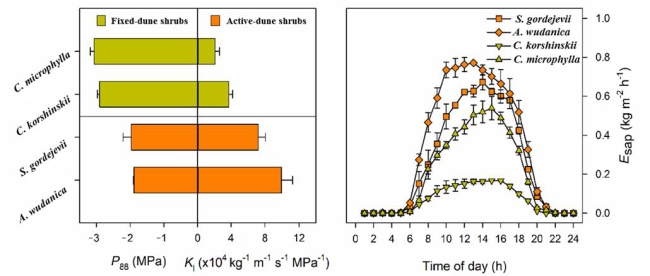
Sand-fixing shrubs play important roles in stabilizing mobile sand dunes. Different sand-fixing shrub species often separate along the temporal-spatial environmental water gradient during the sand dune stabilization process.
However, the physiological mechanisms underlying such a separation remain poorly understood, limiting our ability to plant suitable sand-fixing shrub species according to the soil moisture conditions.
In order to reveal the physiological mechanisms underlying the clear sorting of different sand-fixing shrub species to distinct stages of dune vegetation restoration, researchers from the Institute of Applied Ecology (IAE) of the Chinese Academy of Sciences and their collaborators from the National Council of Science and Technology of Argentina worked at Horqin Sandy Land on comparing the xylem hydraulic properties and water use strategies of four important sand-fixing shrub species.
The four shrub species show distinct preferences to different stages of dune stabilization, i.e. two species succeed in active dunes and the other two in fixed dunes.
The results showed that soil moisture significantly decreased with the stabilization of sand dunes (Fig. 1). The two active-dune species consistently exhibited higher stem hydraulic conductivity but lower resistance to drought-induced xylem embolism than the two fixed-dune species, reflecting contrasting requirements to shrub hydraulic functionality in sand dunes of the two successional stages that differed substantially in soil water regimes (Fig. 2).
In coordination with contrasts in hydraulics, they also diverged clearly in water use strategies with the fixed-dune shrubs showing more conservative water use (Fig. 2).
These findings highlight the critical roles that hydraulics and water utilization play in determining the adaptation of dominating sand-fixing shrub species to their respective environments shaped by the plant-soil interactions during sand dune vegetation development.
The study, published in Forest Ecology and Management, was supported by the National Natural Science Foundation of China, the CAS President's International Fellowship Initiative (PIFI) and the Liaoning Revitalization Talents Program.

Fig. 1. Soil volumetric water content (VWCsoil) of five different soil depths measured at the active and fixed dune site, respectively. (Image by GONG xuewei)

Fig. 2. Hydraulic properties and transpirational water use for two active-dune and two fixed-dune sand-fixing shrub species. (Image by GONG xuewei)

86-10-68597521 (day)
86-10-68597289 (night)

52 Sanlihe Rd., Xicheng District,
Beijing, China (100864)

